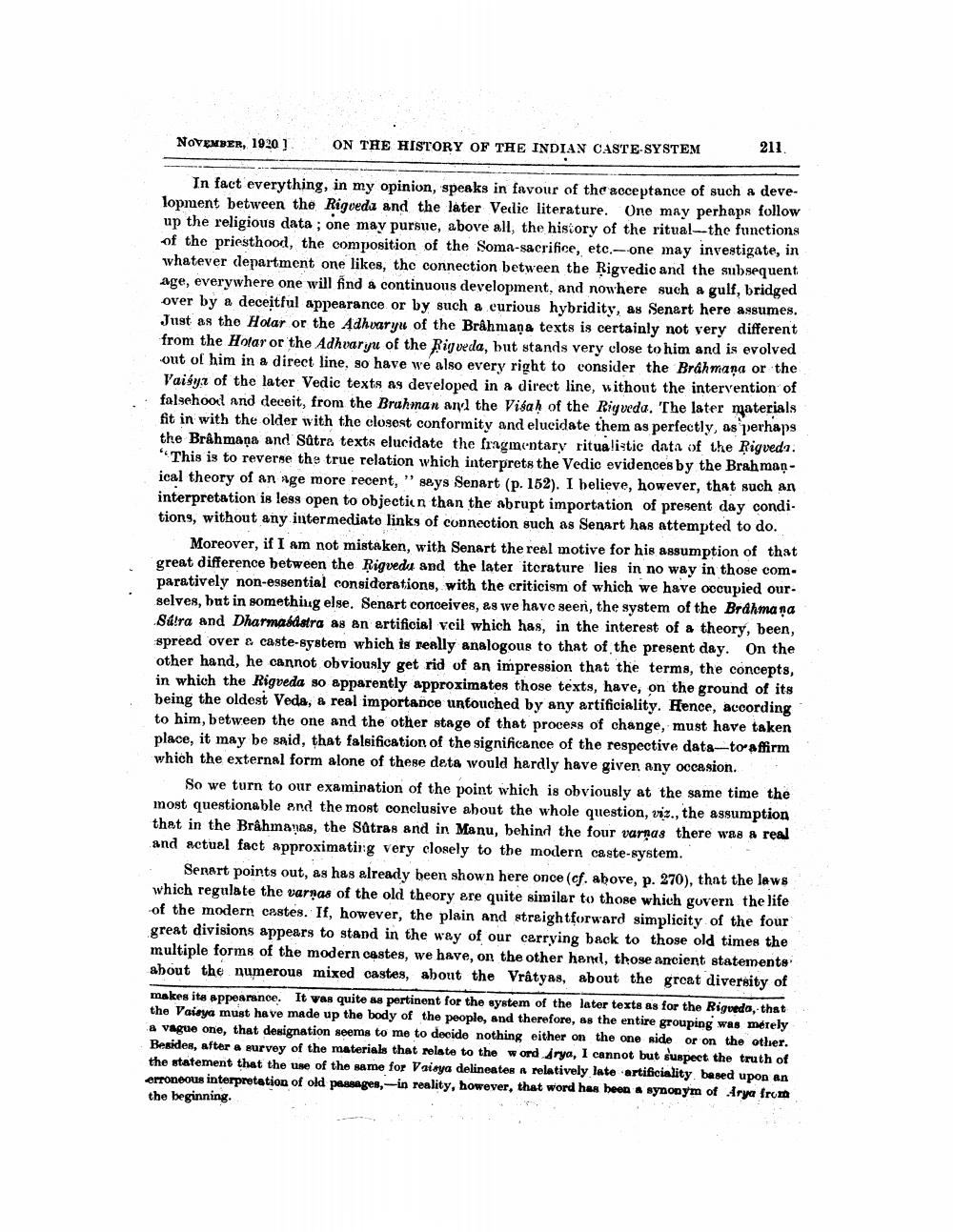________________
NOVEMBER, 1920 )
ON THE HISTORY OF THE INDIAN CASTE-SYSTEM
211
In fact everything, in my opinion, speaks in favour of the acceptance of such a development between the Rigveda and the later Vedic literature. One may perhaps follow up the religious data ; one may pursue, above all, the history of the ritual--the functions of the priesthood, the composition of the Soma-sacrifice, etc.-one may investigate, in whatever department one likes, the connection between the Rigvedic and the subsequent age, everywhere one will find a continuous development, and nowhere such a gulf, bridged over by a deceitful appearance or by such a curious hybridity, as Senart here assumes. Just as the Holar or the Adhvaryu of the Brahmana texts is certainly not very different from the Hotar or the Adhvaryu of the Rigveda, but stands very close to him and is evolved out of him in a direct line, so have we also every right to consider the Brahmana or the Vaisya of the later Vedic texts as developed in a direct line, without the intervention of falsehoort and deceit, from the Brahman any the Vicah of the Rigveda. The later materials fit in with the older with the closest conformity and elucidate them as perfectly, as perhaps the Brâhmana and Sätra texts elucidate the fragmentary ritualistic data of the Rigveda. "This is to reverse the true relation which interprets the Vedic evidenced by the Brahmanical theory of an age more recent," seys Senart (p. 152). I believe, however, that such an interpretation is less open to objection than the abrupt importation of present day condi. tiong, without any intermediate links of connection such as Senart has attempted to do.
Moreover, if I am not mistaken, with Senart the real motive for his assumption of that great difference between the Rigvedu and the later 'iterature lies in no way in those com paratively non-essential considerations, with the criticism of which we have occupied our selves, but in something else. Senart conceives, as we have seen, the system of the Brahma na Satra and Dharmasastra as an artificial veil which has, in the interest of a theory, been, spread over & caste-system which is really analogous to that of the present day. On the other hand, he cannot obviously get rid of an impression that the terms, the concepts, in which the Rigveda so apparently approximates those texts, have, on the ground of its being the oldest Veda, & real importance untouched by any artificiality. Hence, according to him, between the one and the other stage of that process of change, must have taken place, it may be said, that falsification of the significance of the respective data-toaffirm which the external form alone of these deta would hardly have given any occasion.
So we turn to our examination of the point which is obviously at the same time the most questionable and the most conclusive about the whole question, viz., the assumption that in the Brâhmanas, the Satras and in Manu, behind the four varnas there was a real and actual fact approximating very closely to the modern caste-system.
Senart points out, as has already been shown here once (cf. above, p. 270), that the laws which regulate the varnas of the old theory are quite similar to those which govern the life of the modern castes. If, however, the plain and straightforward simplicity of the four great divisions appears to stand in the way of our carrying back to those old times the multiple forms of the modern castes, we have, on the other hand, those ancient statements about the numerous mixed castes, about the Vrâtyas, about the great diversity of makes its appearance. It was quite as pertinent for the system of the later texts as for the Rigveda, that the Vaisya must have made up the body of the people, and therefore, as the entire grouping was merely a vague one, that designation seems to me to decide nothing either on the one side or on the other. Besides, after a survey of the materials that relate to the word Arya, I cannot but suspect the truth of the statement that the use of the same for Vaisya delineates a relatively late artificiality based upon an erroneous interpretation of old passages -- in reality, however, that word has been a synonym of Arya from the beginning.




